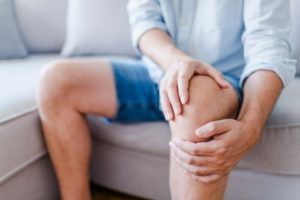Understanding Osteoarthritis: What Does it Mean & What Can We Do?
Introduction
Perhaps you’ve heard terms like “wear and tear”, or “bone-on-bone” before. Perhaps you’re one of the millions of people who experience this so-called “bone-on-bone” feeling on a daily basis. Osteoarthritis, often abbreviated as “OA”, is a prevalent joint condition that affects millions of people worldwide, ranging from a subtle twinge of discomfort to debilitating aches which disrupt daily activities. Although often associated with aging, OA can also develop as a result of joint injury, genetic factors, obesity, and/or other factors. In this blog post, we will explore what osteoarthritis entails and how it impacts people. We will also identify common symptoms and risk factors, discuss diagnostic methods for identifying OA, and explore treatment options. The goal of this blog post is to help empower readers with knowledge to better manage this common musculoskeletal condition, and to help them lead a higher quality of life.
What is Osteoarthritis & Why is it Important?
Osteoarthritis is a degenerative joint condition which affects the cartilage – the tissue which covers bony surfaces of joints throughout the body. Osteoarthritis is the most common form of arthritis and although it typically develops in weight-bearing joints such as the knees, hips and spine, it can also affect the hands and other joints. Through natural “wear and tear” or other processes, cartilage can start to break down, reducing the smooth articulation of joints and the cushion between bones during impact. Cartilage degradation can cause pain, swelling, stiffness and reduced mobility in affected joints, all of which may vary in severity. This may impact a person’s life and may pose difficulties to performing daily activities such as walking or climbing stairs as well as other simple tasks such as opening jars or holding/gripping objects. Osteoarthritis may lead to chronic pain and mobility limitations which can also pose implications for mood, sleep and overall quality of life.
SYMPTOMS
Common symptoms present with osteoarthritis include:
- Joint pain ? Can lead to development of chronic pain
- Joint stiffness
- Swelling
- Reduced range of motion
These symptoms are often hallmark indicators of OA, and may often worsen over time with further cartilage and joint surface degradation. Symptoms may vary in severity depending on a multitude of factors, including:
- Activity level
- Weather changes
- Overall joint health
CAUSES & RISK FACTORS
While the exact cause of osteoarthritis is not fully understood, several factors contribute to its development. These include:
- Aging: Cartilage naturally wears down over time, increasing the risk of osteoarthritis.
- Joint overuse or injury: Repetitive stress or previous joint injuries can accelerate cartilage breakdown due to increased stress on these tissues.
- Obesity: Excess weight puts added strain on weight-bearing joints, contributing to cartilage degeneration.
- Genetics: Family history may predispose individuals to osteoarthritis.
- Joint abnormalities: Conditions such as congenital joint abnormalities or developmental dysplasia can increase the risk of osteoarthritis.
Addressing the need for treating and empowering individuals with osteoarthritis is significant for several reasons. Firstly, the proportion of elderly individuals aged 65 and over on a world-population scale is much larger than before and is only projected to continue increasing, with the WHO suggesting this proportion of elderly individuals to double by 2050. This, in conjunction with rising rates of obesity at population-level, means that a greater proportion of individuals may be at risk of developing osteoarthritis in the coming years due to elevated risk factors at the population-level. With an expected increase in OA prevalence, greater burdens on already-strained healthcare systems will be expected. Herein lies the need to address OA and identify sufficient treatment interventions, as these may help to improve not only the quality of life and well-being of individuals with the condition, but improve the country’s socio-economic well-being as well.
Osteoarthritis vs. Osteoporosis: Are They the Same?
Oftentimes, individuals may be confused between osteoarthritis and osteoporosis. Although they are both musculoskeletal conditions and may sound similar, they affect different parts of the body and have distinct characteristics. As previously mentioned, osteoarthritis primarily affects the cartilage covering bony surfaces in a joint, and is characterized by pain, stiffness and reduced mobility which may arise from the cartilage breakdown. Osteoporosis on the other hand, is a disease which causes bones to become weak, brittle, porous, and more prone to fractures. This disease is characterized by decreased bone mineral density and bone tissue deterioration as a result of an imbalance between bone formation and bone resorption.
Risk factors for OA include age, joint overuse or previous injury history, obesity, genetics and joint abnormalities, whereas risk factors for osteoporosis include age, female biological sex, menopause, low body weight or frailty, as well as family history, smoking, excessive alcohol consumption and certain medications. Despite sounding similar, osteoarthritis and osteoporosis are different in their pathology and risk factors, and will thereby require different diagnostic and treatment interventions.

Diagnosing Osteoarthritis
Diagnosing osteoarthritis typically involves a combined approach of obtaining medical history, performing a physical examination, and performing imaging tests. A doctor will typically ask about symptoms such as joint pain, stiffness, swelling, reduced mobility, as well as aggravating or easing factors. They will also ask about your medical history and any previous injuries, conditions or congenital joint irregularities which may contribute to these symptoms. A physical assessment will help determine current joint function and range of motion, and will help identify specific areas of tenderness, crepitus, joint instability, or inflammation. X-rays are commonly used to help visualize narrowing of joint space, bone spurs or deformities, and/or changes in the alignment of the bones. These characteristic signs of osteoarthritis viewed via imaging tests can be used to help confirm a diagnosis. In some cases, other imaging tests such as CT scans or MRI may be ordered to assess the extent of joint damage, or to rule out other possible diagnoses.

Treating Osteoarthritis
While there is currently no cure for osteoarthritis, treatment typically focuses on managing symptoms, improving joint function, and slowing down the progression of cartilage degradation to promote improved well-being and quality of life. Treatment interventions include:
- Physiotherapy: Customized exercise and stretching routines prescribed by a physical therapist can help strengthen the muscles around the affected joint, improve flexibility, and reduce pain. Physiotherapy may also help highlight existing issues with movement mechanics, and work to re-train these movements to reduce load on affected joints. Physiotherapy clinics may also provide individuals with orthopedic bracing which may help mitigate the burden on affected joints.
- Lifestyle Modifications: Maintaining a healthy weight, avoiding activities that put excessive strain on the joints, using assistive devices like braces or canes if needed, and implementing ergonomic changes in daily activities can help manage symptoms.
- Medications: Pain relievers such as acetaminophen, nonsteroidal anti-inflammatory drugs (NSAIDs), and topical creams or patches can help reduce pain and inflammation.
- Injections: Corticosteroid injections or hyaluronic acid injections directly into the affected joint can provide temporary relief from pain and inflammation. It’s important to note that although these injections may temporarily relieve symptoms, they only act to mask the symptoms and do not “cure” osteoarthritis.
- Surgery: In severe cases where conservative treatments fail to provide relief, surgical options such as arthroscopy, joint realignment, joint replacement (arthroplasty), or joint fusion may be considered.It’s essential for individuals with osteoarthritis to collaborate with healthcare professionals to develop a personalized treatment plan tailored to their specific needs and goals.

Nordic Walking has been shown to demonstrate tremendous benefits among individuals with hip OA not awaiting hip replacement surgery, with studies suggesting more superior benefits than traditional strength training.
Closing
Osteoarthritis is a common joint condition that can significantly impact daily life. By understanding its symptoms, causes, and treatment options, individuals can take proactive steps to manage their condition effectively. Seeking early diagnosis and adopting a comprehensive treatment approach tailored to individual needs can help minimize pain, improve joint function, and enhance overall quality of life for those living with osteoarthritis.
Need Help Starting? Call Us Today!
As experts in movement and rehab in all stages of life, we are here to help you with all of your osteoarthritis needs! Let us help you with pain management and help you return to being YOU!
Visit us or call us at 519-942-8884 today to book with your neighborhood wellness clinic and let our team of specialized health professionals help you get back to being you!


